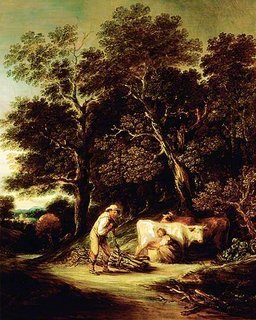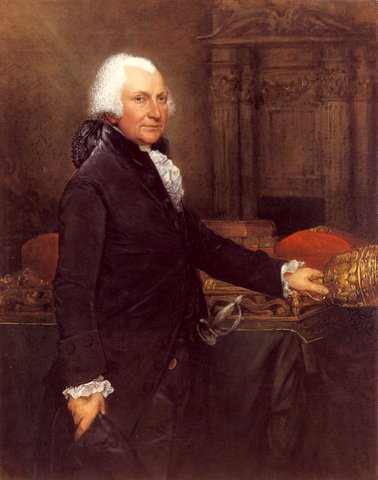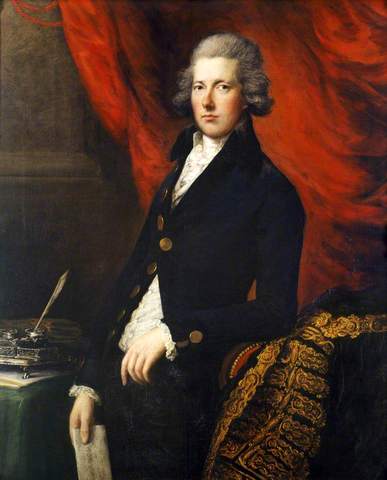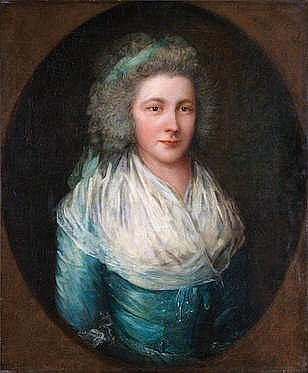DUPONT, Gainsborough
Gainsborough Dupont was baptised at St Peter's church, Sudbury on 28 April 1754, the third of the five children of Philip Dupont (c.1722–1788), a carpenter, and his wife, Sarah Gainsborough (1715-1795), daughter of John Gainsborough and his wife, Mary née Burrough. He was a nephew of the artist Thomas Gainsborough to whom he was apprenticed at Bath on 14 January 1772. Dupont moved to London with his uncle two years later, and on 6 March 1775 entered the Royal Academy Schools, and thereafter became his uncle's studio assistant. During the first fifteen years of his career documented work is rare, but according to a letter from Gainsborough of 29 November 1784, Dupont painted a copy of John Vanderbank's 'Portrait of Queen Caroline' for the Earl of Sandwich. He made mezzotints after his uncle's portraits, the earliest known being of Sir Richard Perryn, published in December 1779. He also painted small-scale copies of his uncle's portraits and fancy pictures, either as a preparation for future prints or as a means of keeping a record of those which Gainsborough painted in the 1780s. After his uncle's death in 1788, Dupont continued to work from his studio at Schomberg House until 1793, when he moved to 17 Grafton Street, Fitzroy Square. He exhibited at the Royal Academy 1790-1795. He was patronised by William Pitt, the younger, and the royal family, but reputably was too shy and nervous to inherit Gainsborough’s practice. The similarity between his work, and that of his uncle's in both drawings and paintings, has often created problems of attribution, however he was able to turn this to his advantage and provide the market with Gainsboroughesque works into the 1790s. By 1793 Dupont's style had become more personal, and he embarked on two important portrait commissions. Thomas Harris (d.1820), proprietor of the Covent Garden Theatre, commissioned him to paint a series of theatrical portraits that were completed by 1795 and included John Quick as Spado and Alexander Pope as Hamlet. A number of these works were later acquired by the Garrick Club, London. The Corporation of Trinity House commissioned an immense group portrait, known as ‘The Great Court Painting’ (1793–1795), commemorating the approval of the designs for a new Trinity House and showing the elder brethren with the architect, Samuel Wyatt. Gainsborough Dupont died, after a short illness, at his home, 17 Grafton Street, London on 4 January 1797 and buried beside his uncle at St Anne's, Kew.
Royal Academy Exhibits
from Pall Mall
1790 75 Cottage Girl
250 Portrait of a Gentleman
251 Portrait of a Lady
385 Portrait of a Gentleman
471 Portrait of a late celebrated Artist
472 Portrait of a Nobleman
1792 20 A Landscape with figures
62 Portrait of a Gentleman
98 Portrait of a Nobleman
122 Portrait of a Gentleman
144 Portrait of a Gentleman
369 A Landscape with figures
404 Portrait of a Gentleman
from 17 Grafton Street, Fitzroy Square
1793 52 Portrait of a Nobleman
122 Portrait of the Lord Mayor
143 Portrait of a Gentleman
249 Portrait of a Nobleman
525 Portrait of a Lady and her Children
1794 85 Portrait of His Majesty
179 Portrait of a Young Gentleman in the character of a Shepherd's Boy
214 Portrait of a Young Lady
268 Mr Quick in the character of Spado
1795 127 Portrait of a Lady
162 Portrait of an Officer
232 Portrait of a Lady
273 Portrait of Mr Lewis
Works by This Artist

|
Wooded Landscape with a Milkmaid and a WoodmanOil on canvas
|

|
John Clementson (1735-1805)Oil on canvas
|

|
The Right Honourable William Pitt the Younger (1759–1806)Oil on canvas
|

|
Portrait of Mrs. Samuel KilderbeeOil on canvas
|